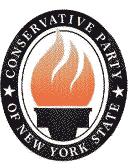Related Research Articles
Electoral fusion is an arrangement where two or more political parties on a ballot list the same candidate, pooling the votes for that candidate. Distinct from the process of electoral alliances in that the political parties remain separately listed on the ballot, the practice of electoral fusion in jurisdictions where it exists allows minor parties to influence election results and policy by offering to endorse or nominate a major party's candidate.
The Liberal Party of New York is a minor American political party that has been active only in the state of New York. Its platform supports a standard set of socially liberal policies: it supports the right to abortion, increased spending on education, and universal health care.

The Conservative Party of New York State is a political party founded in 1962. The Party was founded due to conservative dissatisfaction with the Republican Party in New York. Since 2010, the Conservative Party has held "Row C" on New York ballots—the third-place ballot position, directly below the Democratic and Republican parties—because it received the third-highest number of votes of any political party in the 2010, 2014, and 2018 gubernatorial elections.

The New York City mayoral election of 2005 occurred on Tuesday November 8, 2005, with incumbent Republican mayor Michael Bloomberg soundly defeating former Bronx borough president Fernando Ferrer, the Democratic nominee. They also faced several third party candidates.

The Working Families Party (WFP) is a minor political party in the United States, founded in New York in 1998. There are active chapters in New York, Connecticut, Oregon, New Jersey, Maryland, Washington D.C., Pennsylvania, Wisconsin, Rhode Island, Nevada, West Virginia, New Mexico, Ohio, Texas, and Illinois.

The American Labor Party (ALP) was a political party in the United States established in 1936 which was active almost exclusively in the state of New York. The organization was founded by labor leaders and former members of the Socialist Party of America who had established themselves as the Social Democratic Federation (SDF). The party was intended to parallel the role of the British Labour Party, serving as an umbrella organization to unite New York social democrats of the SDF with trade unionists who would otherwise support candidates of the Republican and Democratic parties.

The mayor of New York City is elected in early November every four years and takes office at the beginning of the following year. The city, which elects the mayor as its chief executive, consists of the five boroughs, which consolidated to form "Greater" New York on January 1, 1898.

The New York gubernatorial election of 2006 took place on November 7, 2006 to elect the governor and lieutenant governor of New York, concurrently with elections to the United States Senate in other states and elections to the United States House of Representatives and various state and local elections. Democrat Eliot Spitzer, the New York Attorney General, won the election, succeeding incumbent Republican Governor George Pataki, who did not run for a fourth term.

The Independence Party is an affiliate in the U.S. state of New York of the Independence Party of America. The party was founded in 1991 by Dr. Gordon Black, Tom Golisano, and Laureen Oliver from Rochester, New York, and acquired ballot status in 1994. Although often associated with Ross Perot, as the party came to prominence in the wake of Perot's 1992 presidential campaign, it was created prior to Perot's run. It currently has one registered member of the New York State Assembly, Fred Thiele.

The New York gubernatorial election of 2010 was held on Tuesday, November 2, 2010. Incumbent Democratic Governor David Paterson, elected as Lieutenant Governor in 2006 as the running mate of Eliot Spitzer, chose not to run for a full term. Democratic New York Attorney General Andrew Cuomo defeated Republican Carl Paladino to become the next Governor of New York.

United States gubernatorial elections were held on November 2, 2010 in 37 states and two territories. As in most midterm elections, the party controlling the White House lost ground. Democrats did take five governorships from the Republicans, and Republicans took 11 governorships from the Democrats. An independent won one governorship previously held by a Republican. A Republican won one governorship previously held by an independent. Republicans held a majority of governorships for the first time since before the 2006 elections. One state, Louisiana, had no election for governor, but did feature a special election for lieutenant governor.

The 1952 Republican presidential primaries were the selection process by which voters of the Republican Party chose its nominee for President of the United States in the 1952 U.S. presidential election. Former U.S. Army General Dwight D. Eisenhower was selected as the nominee through a series of primary elections and caucuses culminating in the 1952 Republican National Convention held from July 7 to July 11, 1952, in Chicago, Illinois.

The New York gubernatorial election of 1994 was an election for the state governorship held on November 8, 1994. Incumbent Democratic Governor Mario Cuomo ran for a fourth term, but was defeated by Republican George Pataki in an upset. Pataki's victory was one of the most notable of the "Republican Revolution" that year.

The 1940 Republican presidential primaries were the selection process by which voters of the Republican Party chose its nominee for President of the United States in the 1940 U.S. presidential election. The nominee was selected through a series of primary elections and caucuses culminating in the 1940 Republican National Convention held from June 24 to June 28, 1940, in Philadelphia, Pennsylvania.

The 2010 New York state elections took place on November 2, 2010. These included elections for both Senate seats and a gubernatorial election.

The 2013 New York City mayoral election occurred on November 5, 2013, along with elections for Comptroller, Public Advocate, Borough President, and members of the New York City Council. The incumbent mayor of New York City, Michael Bloomberg, a Republican-turned-Independent, was term-limited and thus unable to seek re-election to a fourth term in office.

The 2014 New York gubernatorial election took place on November 4, 2014.

An election for Mayor of New York City was held on November 7, 2017. Incumbent Democrat Bill de Blasio won reelection to a second term with 66.5% of the vote against Republican Nicole Malliotakis.

Roque "Rocky" De La Fuente Guerra is an Mexican-American businessman and perennial candidate.

The 2018 New York gubernatorial election occurred on November 6, 2018. Incumbent Democratic Governor Andrew Cuomo won re-election to a third term, defeating Republican Marc Molinaro and several minor party candidates. Cuomo received 59.6% of the vote.
References
- 1 2 3 Martin v. Alverez(Supreme Court, State of New York, Suffolk County2005). Text
- ↑ Peter W. Colby; John Kenneth White; Fred Bartle (1989). New York State Today. SUNY Press. p. 38. ISBN 0-88706-979-7 . Retrieved 2009-04-23.
- 1 2 Joshua Benjamin Freeman (2001). In Transit: The Transport Workers Union in New York City, 1933-1966. Temple University Press. p. 282. ISBN 1-56639-922-X . Retrieved 2009-04-23.
- 1 2 José Ramón Sánchez (1994). Félix M. Padilla (ed.). Handbook of Hispanic Cultures in the United States:Sociology. Arte Público Press, University of Houston. p. 114. ISBN 1-55885-101-1 . Retrieved August 24, 2016.
- ↑ Martin Shefter (1994). Political Parties and the State . Princeton University Press. p. 216. ISBN 0-691-00044-1 . Retrieved 2009-04-23.
+dewey +wilson pakula.
- 1 2 "New York Consolidated Laws, Election Law - ELN § 6-120. Designation and nomination; restrictions". findlaw.com . State of New York. Retrieved August 7, 2019.
- ↑ Elizabeth Benjamin (2009-04-21). "Bloomberg Is Brooklyn GOP's 'Man of The Year'". New York Daily News. Retrieved 2009-04-23.
- ↑ Saltonstall, David (2010-06-03). "State GOP Gives Rick Lazio the Nod to Take on Andrew Cuomo in Gubernatorial Battle". Daily News. New York.
- ↑ "Will Bo Dietl Run as a Republican? Can He?". ShakingNews. 2017-04-25. Retrieved 2017-04-25.
- ↑ "Lawmakers in New York Tied to Bribery Plot in Mayor Race". The New York Times. April 2, 2013. Retrieved April 3, 2013.
- ↑ "Cuomo Unveils Wilson-Pakula Repeal, Electoral Reform". NY State of Politics. April 30, 2013. Retrieved September 11, 2013.